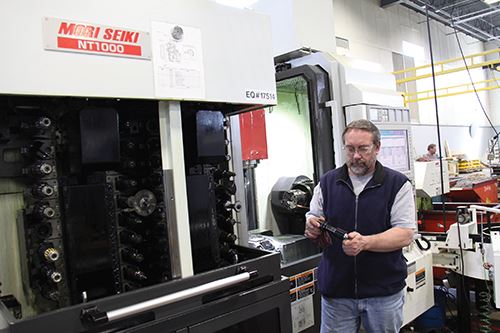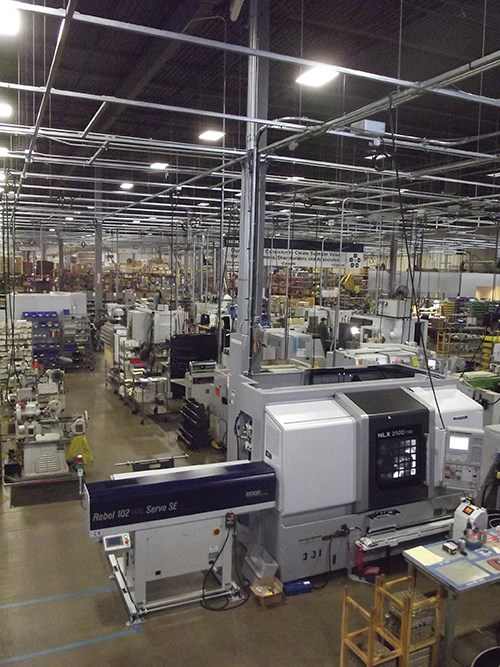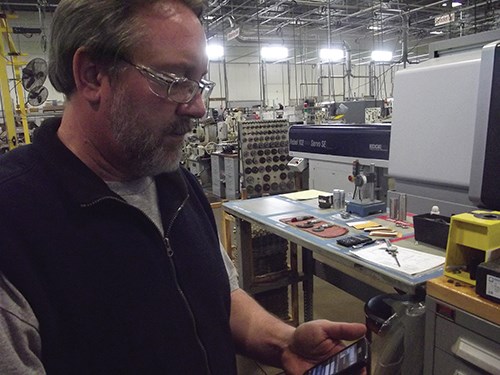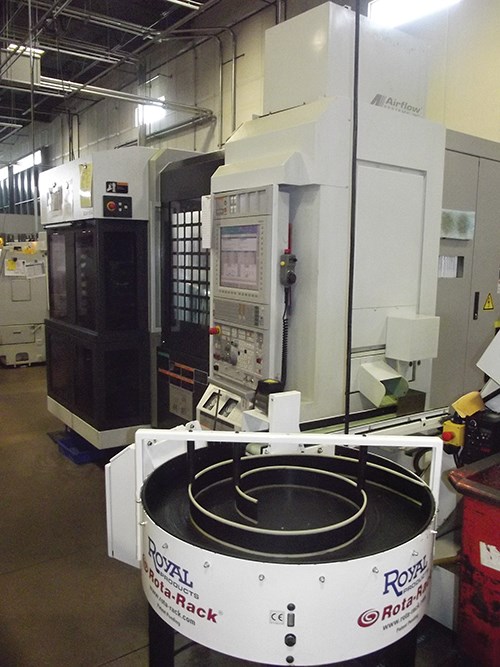Lean Hobbing Gears on a Multi-Axis Machine
Flexible machine tool provides this gear manufacturer with the ability to exceed customer expectations on quality, part accuracy and lead times, all while offering additional design benefits.
Share




Hobbing is a metal-cutting operation where the tool (the hob) and the workpiece rotate simultaneously to generate the gear teeth. This is typically performed on dedicated gear cutting equipment, but the process has become increasingly popular by utilizing multi-axis machine tools. By consolidating processes in a single machine, setup times are reduced and the machine can be tailored to suit a variety of different manufacturing operations such as turning and cutting, etc. This enables gear manufacturers to come up with new and creative ways to standardize their processes, while also reducing their cost per part.
W.M. Berg—a division of the Rexnord Corp., which is headquartered in Milwaukee, Wisconsin—reevaluated its own hobbing operation five years ago in order to find new and more efficient methods to manufacture its spur and helical gears. According to Ted Schmidt, manufacturing engineer, the company began researching multi-axis tools during IMTS 2010. “We were interested in the milling and turning capabilities as well as the toolchanger that keeps the hobs resident inside the machine,” he says. “We also wanted equipment that fit into the lean process and equipment improvements that were taking place at Rexnord at the time.”
With a company-wide push for lean manufacturing, W.M. Berg focused on bringing equipment to the shop floor that could run relatively unattended, offer a stable and repeatable process, and reduce the numerous setups necessary to hob gears in conventional machines. Cost per part and machine performance were key factors in determining what would work best for the changing needs of their customers.
Frank Gentile, plant manager at W.M. Berg, says “We continually drive our business toward specialized engineered solutions. Our customers are coming up with unique gear designs and applications and we need flexible equipment to address these needs, whether we’re producing a single gear or 1,000. While we successfully meet the high-quality demands of our customers, there’s always a push to exceed their expectations.”
Once the company researched the pros and cons of dedicated hobbing equipment versus multi-axis machine tools, it decided to purchase the NT1000 lathe and milling machine from DMG MORI. W.M. Berg was eager to utilize this technology for the production of gears, but the machine offered additional advantages once it was installed on the shop floor, according to Mr. Schmidt.
Precision Component Pedigree
W.M. Berg began as a privately-held family organization in Long Island, New York, in 1967 with an emphasis on engineering and application support. Through the years the company has established itself as a provider of miniature precision mechanical components including gears, gearboxes, sprockets, chains, bearings, couplings and more. The precision components it manufactures are used in a variety of industries including medical, aerospace and communications. These components range in diameter from a quarter-inch to 16", with lot sizes anywhere from one to several thousand pieces.
When the company moved to Wisconsin to join the Rexnord Special Components Division, it reevaluated the hobbing operation. Mr. Schmidt says that W.M. Berg began test runs on the NT1000 at the DMG MORI facility in Hoffman Estates, Illinois. “The reduction in setup time on this machine was a contributing factor from day one,” he says. “Once our parts were approved from the test run we decided to purchase the machine, and within a short period of time we were making AGMA 10-quality catalog gears.”
Multi-Axis Advantages
“When W.M. Berg came to us with their application, we considered a lathe platform and a multi-axis platform to machine the parts,” says Nitin Chaphalkar, gear business product manager for DMG MORI. Mr. Chaphalkar suggested the NT1000 because it offers integrated automation capabilities with a bar feed and rotating second spindle. “The machine was suitable for this application as it could hold the 70-plus tools and hobs required to machine all of the customers’ parts. The B-axis minimum adjustment of 0.0001 degrees allowed W.M. Berg to seamlessly change from hob 1 to hob 2 with different lead angles.”
Mr. Schmidt says the decision to choose a multi-axis machine ultimately came down to flexibility. While being equally capable of producing high-quality gears on dedicated equipment, he felt that the unique capabilities of the NT1000 best fit their needs. “For example, if one of the customers needed to change the bore on a gear by a value as small as 0.0001 inch it would require new workholding equipment on a dedicated gear cutter,” he says. “We’re able to make a simple program change on this machine.”
The part quality was also a factor. The NT1000 is hobbing the workpiece and then boring it; i.e., all critical operations are done in the same clamping which ensures good geometrical tolerances. Everything is done in a single operation. There’s no need to go from fixture to fixture. “You have much more control of the process in this machine,” Mr. Schmidt adds. “There are fewer variables than you’d find on dedicated gear cutting equipment.”
Additionally, tooling costs have been reduced. The tooling is custom, but the company can change the hobs out with off-the-shelf carbide hobs. There are eight hobs in the NT1000 at all times, with a total of 76 stations available. Mr. Schmidt says that the hobs last much longer than the tooling on older gear cutters. There’s also much longer tool life between sharpenings.
Another major factor in purchasing the equipment was the automation capabilities. Mr. Schmidt says that W.M. Berg can’t afford for the components to be dinged or nicked during the production process by dropping them into a bucket, for example. The tilting second spindle on the machine allows the part to come out complete without any handling.
Running the machine unattended or minimally attended 24/7 for a stable, repeatable process has helped the company address surprise customer requests. “If we get calls late in the week and they need the parts the following week, we can accommodate the customer by simply running the machine over the weekend,” Mr. Schmidt says. These last minute requests have been easier to manage thanks to the machine’s remote monitoring capabilities (see "The Benefits of Remote Monitoring").
The accuracy and repeatability of the parts was another significant advantage. “Even if you haven’t run the part for a month or six months, it usually falls right back into spec. You only have to adjust the bore size,” Mr. Schmidt says. “We haven’t had a drop in accuracy on any of our parts since we started running the machine five years ago.”
In addition to helping the company produce high-quality gears faster and more efficiently, the NT1000 plays a role in its push to improve internal quality. The Rexnord Business Systems (RBS) division boasts 28 core business processes that focus on areas like lean manufacturing, Six Sigma and continuous improvement. Brad Pockat, director of RBS, believes the NT1000 can take some credit for putting products in the customer’s hands faster than they have in the past.
“Our on-time delivery was around 90 percent with the dedicated gear cutting equipment,” he says. “Today, we’re meeting customer demand at 98 percent with the multi-axis machines. Anytime you can purchase a flexible, more efficient machining solution that offers turning and cutting capabilities, it puts you in a great position for future business.”
Creative Design Benefits
While the company has created a lean hobbing operation with the NT1000, additional benefits came to fruition once the engineers began putting it to work. The advantage of producing different components has helped the organization diversify its product catalog. The NT1000 alone produces a wide variety of gears and couplings daily.
One in particular is a beam coupling that is made complete on the machine. Mr. Schmidt says the part couldn’t be produced on a standard lathe. He believes it would take four dedicated machines or a four-axis machine dedicated to the specific part to produce a component like this. He also believes the design engineer is really only limited by his or her imagination.
Since the quantities of the gears and couplings may change in the future, the engineers feel that the multi-axis machines are better-suited for this work over dedicated equipment. “We can go from making a gear to a coupling to a part that requires a lot of milling features in the same day,” Mr. Schmidt says. “These complex components can be tricky to manufacture and the fact that we can produce several different sizes and configurations on one unit is a real advantage.”
After working with DMG MORI on all the machine specs and options that would enhance W.M. Berg’s manufacturing operation, the company returned to the OEM when it was interested in a second multi-axis machine. “We purchased the NLX2500 for gear cutting and we’re hoping to supplement some of the work we currently perform on the NT1000,” Mr. Schmidt says. “This will allow us to bridge some of the gaps between our product lines.”
Up next, the company plans to discuss the idea of producing spiral bevel gears. “The NT1000 and NLX25000 currently have full production schedules, but we’re entertaining the idea of branching off into other areas in the gear industry," Mr. Schmidt says.
Read Next
Registration Now Open for the Precision Machining Technology Show (PMTS) 2025
The precision machining industry’s premier event returns to Cleveland, OH, April 1-3.
Read MoreSetting Up the Building Blocks for a Digital Factory
Woodward Inc. spent over a year developing an API to connect machines to its digital factory. Caron Engineering’s MiConnect has cut most of this process while also granting the shop greater access to machine information.
Read MoreBuilding Out a Foundation for Student Machinists
Autodesk and Haas have teamed up to produce an introductory course for students that covers the basics of CAD, CAM and CNC while providing them with a portfolio part.
Read More

























.png;maxWidth=300;quality=90)






.png;maxWidth=970;quality=90)